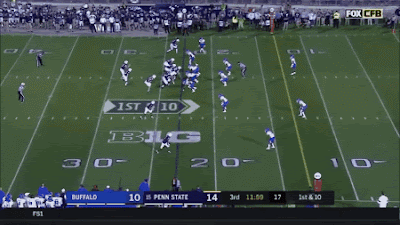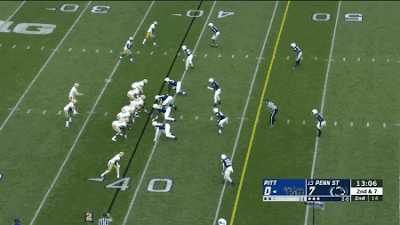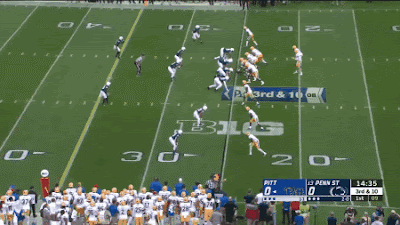Though College GameDay will be in Tuscaloosa, the Gophers will have the spotlight to themselves in the biggest game of the 11:00 window. It's a matchup between two unbeatens — a Playoff contender and perennial power against a rebuilt program at 8-0 for the first time since before the Pearl Harbor attack — who can boost their chances of a New Year's Six bowl with a win.
Though the Gophers will still lead the Big Ten West if they lose, beating the Nittany Lions would give their undefeated start some legitimacy and maybe even get fatalistic Minnesotans to believe in them. An upset could dramatically shift the public perception of the program. In a sport where perception affects reality, the result of this game is potentially monumental.
2019 to Date
The Nittany Lions have passed every test this season, often convincingly. Their closest games have been against two top-10 defenses (Iowa and Michigan) and the ever-confounding Pitt, whose defense is still good. Buffalo led PSU 10-7 at halftime but were outscored by five touchdowns in the second half. Michigan State's defense made the Nittany Lions work hard, but the Spartans' offense, usually unimpressive, was downright hopeless.
Offense
Though not as sensational as past iterations, the Penn State offense remains one of the Big Ten's best, which makes it one the country's best. By SP+, it ranks 14th in FBS. By Massey, it is 11th. By FPI, it is 6th, which is even higher than PSU's generally better regarded defense.
The biggest reason for their high level of performance this season is their passing game. Redshirt sophomore Sean Clifford is 16th in the country in yards per pass attempt and tied for 15th in passing touchdowns. Though much of offensive coordinator Ricky Rahne's approach is based on short passes, Clifford still gets enough opportunities to throw deep. His throws in those moments can be fantastic.
Clifford has made a name for himself as a scrambler as well. He can dodge tacklers and throw effectively on the run.
If there is a problem with Clifford's game, it's that he isn't always comfortable in the pocket. In the following play, he broke from a clean pocket almost immediately upon seeing a blitz on his left and a blocker conceding some ground on his right.
Additionally, his stats are significantly boosted by yards coming after the catch. K.J. Hamler will do that.
The word "freak" gets thrown around too often with athletes, but Hamler's speed and agility is nothing short of freakish. His coaches clocked his 40-yard dash time at 4.28 seconds, which one might reasonably accuse of inaccuracy if Hamler was not capable of stuff like this:
Hamler is arguably the most entertaining player in college football right now. His highlights are frequent and astonishing. He turns simple screens and swings into remarkable plays.
The weapons don't end with Hamler. Clifford's next-most frequent targets are Jahan Dotson, averaging 18.4 yards per catch, and tight end Pat Freiermuth, who has scored seven touchdowns this season. Freiermuth in particular is a serious red zone threat:
Clifford frequently throws to his running backs, too. The Nittany Lions' four primary backs — Noah Cain, Journey Brown, Ricky Slade, and Devyn Ford — have combined for 39 targets.
As runners, they're used less often (in part because James Franklin does not believe in letting up with a big lead), but they remain effective enough, together averaging 5.3 yards per carry. Much of that figure is the result of the running backs' own talent, as the offensive line does not grade very well in some advanced metrics. The Nittany Lions are 94th in Line Yards per Carry and 79th in Opportunity Rate (each explained in the link). Overall, they are decent at running the ball, with ample potential for chunk plays.
Clifford might be the most dangerous runner PSU has. He might be too ready to take off instead of staying in the pocket, but he's also capable of stuff like this on designed runs:
Clifford runs plenty of read option and draws, the latter of which often come on 3rd down. Rahne knows he has a multi-use weapon at the position, and he uses it.
Rahne's favorite kinds of plays are pretty easy to figure out. Swings (and other passes to the flat) are a mainstay; how many coordinators call them for their tight ends?
Quick tosses like this are also frequent:
He uses designs that counter off of those mainstays, too. Here's an out route off of what looks before the snap like a swing pass to Slade:
And here's Clifford faking a toss, successfully distracting two Michigan defenders, and scoring a touchdown.
Though much of Penn State's offensive success comes from giving their most talented skill players chances to pick up yards after the catch, Rahne's tactics also play a major role. The combination of athleticism and deception in this offense makes it a blast to watch when it's moving smoothly.
There have been a few instances when it hasn't run smoothly this season. Against Pitt, Iowa, Michigan, and Michigan State, Penn State averaged 4.8 yards per play. Those are all good defenses, so a decline is to be expected, but offenses who average that figure sit in the bottom 15 of FBS. Something didn't click against those four teams.
Looking at the stats, a pattern is clear: Clifford either couldn't get going or looked average at best. In those games, he completed 52.3 percent of his passes (nearly 10 points down from his season average), and he was sacked 10 times. The Nittany Lions' passing success rate was below the national average of 41 percent in all but the Iowa game. Their success rate on passing downs was also poor, dipping below 20 percent against Iowa and Michigan.
Minnesota has something in common with those defenses: All five of them rank 22nd or better in yards per passing attempt allowed. More specifically, Minnesota ranks 13th.
The relative ease of the Gophers' early schedule is well-known. The Nittany Lions' passing attack is more than a little better than those of Georgia Southern or Maryland. But their passing struggles in their worst four games suggest a possible opening.
If Minnesota's pass defense is even close to being as good what the stats suggest it is, Minnesota may have an answer for Penn State's offense.
Defense
As strong as the Penn State offense is, the defense is the better unit. Opponents average 4.0 yards per play — 4.6 net yards per passing attempt and 3.2 yards per rushing attempt. The Nittany Lions are talented in the back and dominant up front.
Each level of the defense rotates regularly, and that's especially true on the line. Antonio Shelton, suspended for Saturday's game after spitting on a Michigan State player, has started every game this year but is is tied for only the third-most tackles among Penn State defensive tackles. P.J. Mustipher is more productive at the 3-technique (15.5 tackles), but Robert Windsor is a threat at nose. He often cannot make an impact because he so often faces double-teams, but he showed against Iowa that he can wreck plays. Windsor finished that game with 3.5 tackles, 2.5 of which were for losses, and 1.5 sacks on 7 pressures.
 |
| Windsor is No. 54. |
Former four-star tackles Fred Hansard and Damion Barber see lesser roles normally, but they'll have to fill in with Shelton out Saturday.
The starting defensive ends are Yetur Gross-Matos and Shaka Toney. Gross-Matos has more tackles and tackles for loss than Toney, reflecting a bigger role in run defense, but their matching sack totals (5.5 each) show that they are both fearsome pass rushers. Toney in particular can take advantage of a slower offensive tackle.
Backup ends Shane Simmons, Jayson Oweh, and Adisa Isaac all play plenty. Sometimes on passing downs, that means a line made entirely of defensive ends. It makes Penn State's pass rush a little quicker.
Penn State has a lot of size at each outside linebacker spot. The 6-foot-2-inch Micah Parsons is far and away the team's leading tackler (41.5 tackles, 9.0 more than second place) and a force in run defense. He's got impressive speed that allows him to make plays even from less-than-ideal positions.
Weak side linebacker Cam Brown, at 6-foot-5-inches, is as big as a typical tight end. (On the Gophers' roster, Brevyn Spann-Ford is the only tight end taller.) He is not as disruptive, but he makes tackles and closes holes.
Middle linebacker Jan Johnson, tied with Brown for the lead at the position in passes defensed, is the best of the three starters in coverage. The other two are lacking; Brown usually leaves the field in nickel situations. Ellis Brooks, who has 2.5 sacks, sometimes sees the field as a 3rd down blitzer, and Jesse Luketa, who has four pass breakups, sees significant time as well.
Defensive coordinator Brent Pry uses a lot of zone coverage. Though he blitzes a decent amount, and he occasionally calls for man coverage, his favorite tactic is dropping his defensive backs.
 |
| Cover 2 |
 |
| Cover 3 |
All this zone coverage, combined with linebackers who don't cover very well, means that the Nittany Lions can concede a lot of space near the line of scrimmage. On 3rd down, they often play even with or beyond the sticks, relying on their athleticism to make plays. This doesn't always work.
Other times, receivers can ease into the spaces between zones without much resistance.
If the Gophers can attack these uncovered spaces, they can move the ball. Buffalo and Pitt also made some significant gains with screens...
...and with passing against a loaded box.
Screens on 3rd down are rather predictable, and you may recall a GIF of a Michigan State screen going nowhere a bit higher up the page. But Minnesota can bring defenders to the line of scrimmage with bigger personnel and tighter formations. Considering how much Kirk Ciarrocca loves of running out of 13 personnel in short-yardage situations, the Nittany Lions will surely be expecting a lot of runs in those spots. Ciarrocca should break from that tendency if the defense's alignment presents the opportunity. Maybe it would be a good time to resurrect the Seth Green pop pass.
Penn State does not normally crowd the line. Pry's 4-3 base is usually backed off to a normal distance. The Nittany Lions' nickel package takes a couple of different forms: a 4-2-5, with a linebacker leaving the field, and a far less common 3-3-5, with a defensive lineman leaving.
 |
| 4-2-5 (The edge defender on the far side is the cornerback.) |
 |
| 3-3-5 (Note that the three linemen are all ends.) |
In the secondary, the best players are at cornerback. Fifth-year senior John Reid and junior Tariq Castro-Fields have combined for 17 passes defensed. Perhaps it's more out of familiarity than anything (this is Reid's third season as a full-time starter and Castro-Fields' first), but I like Reid more. He's long been both physical and smart in coverage and a dependable tackler in the open field.
 |
| Reid is the corner at the top of the screen. |
Though Castro-Fields will miss tackles from time to time, he's no slouch. Tyler Johnson, Rashod Bateman, and Chris Autman-Bell face tough matchups on the outside.
The back of the secondary isn't as good, but it's strong enough. Lamont Wade (not to be confused with LaMonte Wade) plays multiple roles, starting as a traditional safety and often going to nickelback. He and the other safety, Garrett Taylor, are tied for second on the team in tackles. Taylor and Jaquan Brisker (Wade's usual fill-in in nickel) are worse than Wade at both tackling and coverage. They are still good enough players, however — if they weren't, opposing teams would have a much easier time passing the ball.
The thing is, we don't know just how good the Nittany Lions' pass defense is. It has allowed the 14th-fewest yards per passing attempt in FBS this season. At its best, it's been phenomenal. The rest of the time, it's been pretty good, but not much more than that.
The numbers in the first row are those of a top-five pass defense. The numbers in the second row are those of a top-40 pass defense (with a bottom-20 pass rush). The disparity is seemingly not attributable to opponent: By yards per passing attempt, Buffalo and Pitt are the two worst FBS passing offenses Penn State has faced. Michigan and Iowa are the two best, but they rank 66th and 76th, respectively. Those four have had the most success against Penn State.
Though Buffalo allows the 7th-lowest sack rate in the country, there's no obvious correlation between a team's allowed sack rate and which bucket a team falls into in the above table. Michigan State ranks 25th. Among FBS opponents, Maryland is worst at 85th. Everyone else falls in the middle.
Like the Gophers, the Nittany Lions have played some bad passing attacks and posted great numbers. The Gophers' offense, meanwhile, is sixth in FBS in yards per passing attempt. That's a bit more difficult.
Ciarrocca should test the strength of this passing defense, particularly going after the linebackers. The talent at his disposal — at quarterback and at receiver — is too good, and the opposing run defense is too formidable, to make this a game about "establishing the run." The air could be the route to success.
Special Teams
Penn State uses a pair of kickers. Jake Pinegar handles all the extra points and short and medium-length field goal attempts. Jordan Stout is the kickoff specialist, and his only field goal attempts have been from beyond 50 yards. Pinegar is 5-for-6 this season, and Stout is 2-for-3.
Senior Blake Gillikin was one of the Big Ten's best punters in previous seasons but is averaging the fewest yards per punt of his career this season. He still has punted for 50 or more yards eight times this season, bringing his career total to 50 times. Gillikin's leg can flip the field.
The Penn State return teams have been unremarkable despite giving Hamler most of the opportunities. Hamler has fumbled twice on kickoffs to go with his pedestrian 21.4 yards per kick return and 5.5 yards per punt return. No Penn State player has scored a touchdown on a kick or punt return. Still, when facing a player that electric, the coverage team must do its job.
Senior Blake Gillikin was one of the Big Ten's best punters in previous seasons but is averaging the fewest yards per punt of his career this season. He still has punted for 50 or more yards eight times this season, bringing his career total to 50 times. Gillikin's leg can flip the field.
The Penn State return teams have been unremarkable despite giving Hamler most of the opportunities. Hamler has fumbled twice on kickoffs to go with his pedestrian 21.4 yards per kick return and 5.5 yards per punt return. No Penn State player has scored a touchdown on a kick or punt return. Still, when facing a player that electric, the coverage team must do its job.
Conclusion
The talent disparity between these two teams is significant. For that reason, I will not pick against the Nittany Lions. But neither pass defense has been tested against an offense like the one each will face Saturday. This could easily end up a high-scoring, back-and-forth game whose winner is not determined until the last few minutes. Alternatively, the two secondaries could buckle down and show why their stats are so good. It's hard to say which way it will play out, but I expect (assuming nothing funky happens with turnovers and special teams) that the team that wins in the air will win the game.
There's no need to reiterate the magnitude of this game for Minnesota, but I will anyway. Tickets are sold out. ESPN's No. 2 broadcast team — Sean McDonough, Todd Blackledge, and Holly Rowe — will cover the game for ABC with little competition for viewers on other channels. The College Football Playoff Committee ranked Minnesota 17th, essentially a "show me" ranking. An upset win will give the Gophers a big rankings bump and could make a difference in the West race or determining who goes to the Rose Bowl. This is the biggest stage for Minnesota football in years.
For believers in the power of historical poetry, it is worth noting that 20 years ago this Wednesday, a Gophers team of far smaller stature beat the then-No.2 Nittany Lions 24-23 at Beaver Stadium. Dan Nystrom's walk-off field goal, which just barely missed LaVar Arrington on its way over the line, is one of the greatest plays in recent program history.
Nystrom was a true freshman at the time. Coincidentally, current Minnesota field goal kicker Michael Lantz is a true freshman. Should Lantz make a kick of similar magnitude, the symmetry would be incredible. It would also be another signature moment for a program lacking in them since college football's post-NCAA v. Oklahoma television boom.
Before the Gophers played for Paul Bunyan's Axe last November, Fleck told his players, "Be not afraid, men. Do not be afraid to be a legend." The 37-15 victory that followed will be celebrated for years. The Gophers produced a signature moment and became legends.
On Saturday, perhaps with the smallest bit of fortune, they can be legends again.
Prediction: Penn State 38-31 Minnesota



























No comments:
Post a Comment
Note: Only a member of this blog may post a comment.